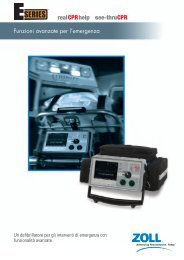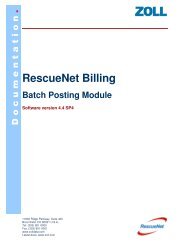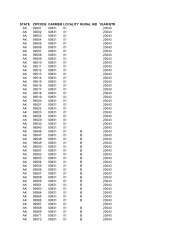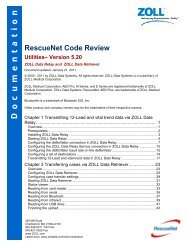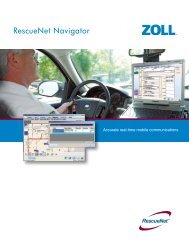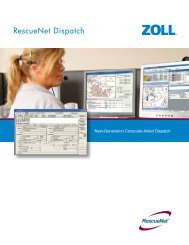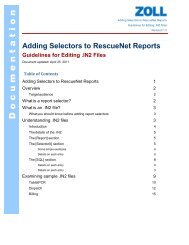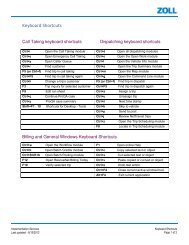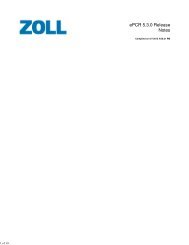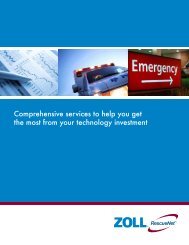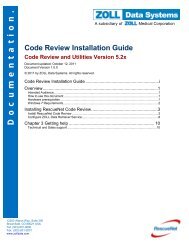Implementing Condition Codes in RescueNet Billing - ZOLL Data ...
Implementing Condition Codes in RescueNet Billing - ZOLL Data ...
Implementing Condition Codes in RescueNet Billing - ZOLL Data ...
Create successful ePaper yourself
Turn your PDF publications into a flip-book with our unique Google optimized e-Paper software.
<strong>Implement<strong>in</strong>g</strong><br />
<strong>Condition</strong> <strong>Codes</strong> <strong>in</strong><br />
<strong>RescueNet</strong> Bill<strong>in</strong>g
Table of Contents<br />
UNDERSTANDING MEDICAL CONDITIONS LIST ...........................................................................................1<br />
ICD9 PRIMARY CODE................................................................................................................................................2<br />
ICD9 ALTERNATIVE SPECIFIC CODE .........................................................................................................................2<br />
SERVICE LEVEL .........................................................................................................................................................2<br />
TRANSPORTATION INDICATORS .......................................................................................................................2<br />
UPDATING THE COMPLAINTS LIST IN RESCUENET BILLING..................................................................3<br />
USING THE POLICY FIELD ..........................................................................................................................................4<br />
USE OF NATURE OF CALL FIELD IN V3.8 .........................................................................................................5<br />
APPENDIX A: CONFIGURING PAYOR SPECIFIC OVERRIDES FOR COMPLAINTS...............................7
Understand<strong>in</strong>g Medical <strong>Condition</strong>s List<br />
CMS released the medical conditions list on December 23, 2005 <strong>in</strong> Pub 100-04. That publication<br />
details the ambulance conditions list and <strong>in</strong>structions for use 1 . This document and correspond<strong>in</strong>g<br />
web sem<strong>in</strong>ar summarize the official publication and provide directions for implement<strong>in</strong>g the list<br />
<strong>in</strong> your <strong>RescueNet</strong> Bill<strong>in</strong>g software.<br />
Emergency <strong>Condition</strong>s - Non-Traumatic<br />
ICD9<br />
Primary<br />
Code<br />
ICD9 Alternative<br />
Specific Code<br />
535.50 458.9, 780.2, 787.01,<br />
787.02, 787.03, 789.01,<br />
789.02, 789.03, 789.04,<br />
789.05, 789.06, 789.07,<br />
789.09, 789.60 through<br />
789.69, or 789.40 through<br />
789.49 PLUS any other<br />
code from 780 through<br />
799 except 793, 794, and<br />
795.<br />
789.00 726.2, 789.01, 789.02,<br />
789.03, 789.04, 789.05,<br />
789.06, 789.07, or 789.09.<br />
427.9 426.0, 426.3, 426.4,<br />
426.6, 426.11, 426.13,<br />
426.50, 426.53, 427.0,<br />
427.1, 427.2, 427.31,<br />
427.32, 427.41, 427.42,<br />
427.5, 427.60, 427.61,<br />
427.69, 427.81, 427.89,<br />
785.0, 785.50, 785.51,<br />
785.52, or 785.59.<br />
<strong>Condition</strong><br />
(General)<br />
Severe<br />
abdom<strong>in</strong>al pa<strong>in</strong><br />
Abdom<strong>in</strong>al pa<strong>in</strong><br />
Abnormal<br />
cardiac<br />
rhythm/Cardiac<br />
dysrythmia.<br />
780.8 782.5 or 782.6 Abnormal sk<strong>in</strong><br />
signs<br />
796.4 458.9, 780.6, 785.9,<br />
796.2, or 796.3 PLUS any<br />
other code from 780<br />
through 799.<br />
995.0 995.1, 995.2, 995.3,<br />
995.4, 995.60, 995.61,<br />
995.62, 995.63, 995.64,<br />
995.65, 995.66, 995.67,<br />
995.68, 995.69 or 995.7.<br />
692.9 692.0, 692.1, 692.2,<br />
692.3, 692.4, 692.5,<br />
692.6, 692.70, 692.71,<br />
692.72, 692.73, 692.74,<br />
692.75, 692.76, 692.77,<br />
692.79, 692.81, 692.82,<br />
692.83, 692.89, 692.9,<br />
693.0, 693.1, 693.8,<br />
693.9, 695.9, 698.9,<br />
708.9, 782.1.<br />
Abnormal vital<br />
signs (<strong>in</strong>cludes<br />
abnormal pulse<br />
oximetry).<br />
Allergic<br />
reaction<br />
Allergic<br />
reaction<br />
<strong>Condition</strong><br />
(Specific)<br />
With other<br />
signs or<br />
symptoms<br />
Without other<br />
signs or<br />
symptoms<br />
Potentially lifethreaten<strong>in</strong>g<br />
With or without<br />
symptoms.<br />
Potentially lifethreaten<strong>in</strong>g<br />
Service<br />
Level<br />
ALS<br />
BLS<br />
ALS<br />
ALS<br />
ALS<br />
ALS<br />
Comments and<br />
Examples (not all<strong>in</strong>clusive)<br />
Nausea, vomit<strong>in</strong>g, fa<strong>in</strong>t<strong>in</strong>g,<br />
pulsatile mass, distention,<br />
rigid, tenderness on exam,<br />
guard<strong>in</strong>g.<br />
Bradycardia, junctional and<br />
ventricular blocks,non-s<strong>in</strong>us<br />
tachycardias, PVC’s >6, bi<br />
and trigem<strong>in</strong>y, ventricular<br />
tachycardia , ventricular<br />
fibrillation, atrial flutter, PEA,<br />
asystole, AICD/AED Fired<br />
Diaphorhesis, cyanosis,<br />
delayed cap refill, poor<br />
turgor, mottled.<br />
Other emergency conditions,<br />
rapid progression of<br />
symptoms, prior hx. Of<br />
anaphylaxis, wheez<strong>in</strong>g,<br />
difficulty swallow<strong>in</strong>g.<br />
Other BLS Hives, itch<strong>in</strong>g, rash, slow<br />
onset, local swell<strong>in</strong>g,<br />
redness, erythema.<br />
HCPCS<br />
Crosswalk<br />
A0427/A0433<br />
A0429<br />
A0427/A0433<br />
A0427/A0433<br />
A0427/A0433<br />
A0427/A0433<br />
A0429<br />
1 CMS and the committee that developed the Medical <strong>Condition</strong>s List acknowledge that the list of condition codes<br />
as def<strong>in</strong>ed by the Primary ICD9 codes represent a complete list that can be used to successfully code all claims<br />
where Medicare is primary. However, they also caution that it may be possible that other commercial <strong>in</strong>surance<br />
carriers may not <strong>in</strong>terpret these codes as def<strong>in</strong>ed <strong>in</strong> the CMS Medical <strong>Condition</strong>s List, as the ICD9 code<br />
may represent a different def<strong>in</strong>ition, as def<strong>in</strong>ed by the AMA, to the commercial <strong>in</strong>surance carriers. With this <strong>in</strong> m<strong>in</strong>d<br />
it is recommended that your organization cont<strong>in</strong>ue all current cod<strong>in</strong>g practices for non-Medicare claims to ensure<br />
the most appropriate ICD9 codes are communicated to each carrier for the adjudication process.<br />
1
ICD9 Primary Code<br />
This column conta<strong>in</strong>s general codes that def<strong>in</strong>e the condition of the patient at time of transport<br />
(as described <strong>in</strong> the other columns). Bill<strong>in</strong>g staff or ambulance personnel with limited ICD9<br />
cod<strong>in</strong>g skills would pick one or one of the two codes from this column that best fit the transport.<br />
It is important to note that the codes conta<strong>in</strong>ed <strong>in</strong> this column are <strong>in</strong>tended to be comprehensive<br />
and applicable to all transports billed to Medicare.<br />
ICD9 Alternative Specific Code<br />
If bill<strong>in</strong>g staff or ambulance personnel have more advanced cl<strong>in</strong>ical knowledge or ICD9 cod<strong>in</strong>g<br />
skills, they may choose a code from this column. It is not necessary to select a code from the<br />
Primary Code column and then use a second code from the Alternative Specific Code<br />
column. However, some codes <strong>in</strong> this column are followed by the word “PLUS”. For these<br />
codes, you would choose a code from the top part of the list, and use at least one additional code<br />
from the bottom part of the list (after the word “PLUS”).<br />
ICD9<br />
Primary<br />
Code<br />
ICD9 Alternative<br />
Specific Code<br />
535.50 458.9, 780.2, 787.01,<br />
787.02, 787.03, 789.01,<br />
789.02, 789.03, 789.04,<br />
789.05, 789.06, 789.07,<br />
789.09, 789.60 through<br />
789.69, or 789.40 through<br />
789.49 PLUS any other<br />
code from 780 through<br />
799 except 793, 794, and<br />
795.<br />
<strong>Condition</strong><br />
(General)<br />
Severe<br />
abdom<strong>in</strong>al pa<strong>in</strong><br />
<strong>Condition</strong><br />
(Specific)<br />
With other<br />
signs or<br />
symptoms<br />
Service<br />
Level<br />
ALS<br />
Comments and<br />
Examples (not all<strong>in</strong>clusive)<br />
Nausea, vomit<strong>in</strong>g, fa<strong>in</strong>t<strong>in</strong>g,<br />
pulsatile mass, distention,<br />
rigid, tenderness on exam,<br />
guard<strong>in</strong>g.<br />
HCPCS<br />
Crosswalk<br />
A0427/A0433<br />
Service Level<br />
If an ALS level ambulance is sent to a call that was received by the dispatcher as need<strong>in</strong>g an<br />
ALS assessment, and upon arrival on scene, the ambulance crew encounters a BLS level<br />
condition, the claim should <strong>in</strong>clude two condition codes. The first def<strong>in</strong>es the reason for transport<br />
(patient’s condition) and a second code that corresponds to the <strong>in</strong>formation captured by dispatch.<br />
For customer’s us<strong>in</strong>g <strong>RescueNet</strong> Dispatch and Bill<strong>in</strong>g version 3.8, this <strong>in</strong>formation can be<br />
captured through the Nature of Call field (discussed later).<br />
Transportation Indicators<br />
CMS has also def<strong>in</strong>ed Transportation Indications that may be <strong>in</strong>cluded on the claim to further<br />
def<strong>in</strong>e the transport. If used, these <strong>in</strong>dicators would be placed <strong>in</strong> the Narrative box on 2-Medical<br />
Tab of Call Tak<strong>in</strong>g.<br />
2
Updat<strong>in</strong>g the Compla<strong>in</strong>ts List <strong>in</strong> <strong>RescueNet</strong> Bill<strong>in</strong>g<br />
Your system’s current list of Compla<strong>in</strong>ts may or may not already conta<strong>in</strong> some or all of the ICD9<br />
codes def<strong>in</strong>ed on the Medical <strong>Condition</strong>s List. Use <strong>RescueNet</strong> Adm<strong>in</strong>istration to access the<br />
Compla<strong>in</strong>ts list.<br />
**Remember, before any ICD9 code (either from the Primary Code column or the<br />
Alternative Specific Code column <strong>in</strong> the Medical <strong>Condition</strong>s List) can be used on a<br />
trip/claim, it must first exist <strong>in</strong> <strong>RescueNet</strong> Adm<strong>in</strong>istration. Each agency is responsible for<br />
add<strong>in</strong>g, edit<strong>in</strong>g and ma<strong>in</strong>ta<strong>in</strong><strong>in</strong>g their Compla<strong>in</strong>ts list.<br />
3
Us<strong>in</strong>g the Policy Field<br />
You may want to use the Policy field <strong>in</strong>side of each compla<strong>in</strong>t to make additional notes about the<br />
Service Level, HCPCS Code(s) for each compla<strong>in</strong>t and/or any other comments about the<br />
condition that would not fit <strong>in</strong> the Description field. This may be helpful to the dispatch or bill<strong>in</strong>g<br />
staff that may be add<strong>in</strong>g a compla<strong>in</strong>t to 2-Medical Tab of a trip. This <strong>in</strong>formation does NOT<br />
transmit as part of the claim.<br />
4
Use of Nature of Call Field <strong>in</strong> v3.8<br />
A Nature of Call Field was added <strong>in</strong> <strong>RescueNet</strong> Dispatch version 3.8. This field can also be<br />
configured to add a condition code (ICD9 code) to the trip at the time the call is taken by the<br />
dispatcher.<br />
Nature of Call can be found <strong>in</strong> <strong>RescueNet</strong> Adm<strong>in</strong>istration, under the Natures, Call Types, and<br />
Priorities folder.<br />
5
Edit an exist<strong>in</strong>g Nature to <strong>in</strong>clude the appropriate ICD9 code.<br />
6
Appendix A: Configur<strong>in</strong>g Payor Specific Overrides for<br />
Compla<strong>in</strong>ts<br />
It is important to remember that the condition code you select will not change if you need to<br />
change the primary payor from Medicare to a commercial or other type of payor, unless you use<br />
the payor override functionality <strong>in</strong> the Compla<strong>in</strong>t configuration. You need to ascerta<strong>in</strong> if <strong>in</strong>surers<br />
other than Medicare will accept the ‘crosswalked’ ICD-9 code, as the <strong>in</strong>tended description of the<br />
condition code does not exactly match the def<strong>in</strong>ition supplied by the AMA.<br />
In situations <strong>in</strong> which you determ<strong>in</strong>e the ‘crosswalked’ ICD-9 code is only appropriate for use<br />
when bill<strong>in</strong>g Medicare and prefer to use different ICD-9 code for all other payors we recommend<br />
configur<strong>in</strong>g the condition code as follows:<br />
1. Def<strong>in</strong>e the condition code as usual with the medical condition as the description and<br />
policy <strong>in</strong>formation.<br />
2. Remove the ‘crosswalked’ ICD-9 code from the default ICD-9 code field and <strong>in</strong>stead<br />
enter the desired ICD-9 code you wish to submit to all other payors besides Medicare.<br />
3. Enter a payor-specific ICD-9 override for Medicare and enter the ‘crosswalked’ ICD-9<br />
code here.<br />
7



